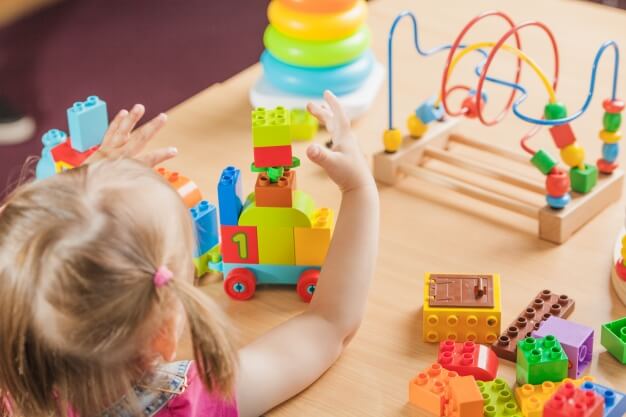Once a child has reached the age of 2 years it is expected that he will be walking and talking, capable of feeding himself, undergoing potty training, and able to successfully interact with a number of simple educational toys.
At this age the child is able to absorb a significant amount of knowledge and will be constantly learning new things. He will begin to explore beyond the boundaries of the space he was protected by in his first two years. He will learn to walk longer distances, to run, and to kick a ball without falling over. His motor skills will be constantly improving through play and day-to-day tasks.

From around the age of 2 a child is introduced to books that are more than just soft paged books with colorful pictures. He will be able to recognize shapes, animals and much more. This step is the pre-cursor to reading and is vitally important to a child in his toddler years. Interaction with other children of similar ages will help a toddler learn social skills. Provided his emotional well-being is nurtured within the home he will learn to share toys and play equipment with other children, often enjoying the experience of having someone his age to play with. Physically a child will develop significantly during his toddler years. He will grow taller, stronger and become better coordinated. He will learn to enjoy all that his body can do i.e. running, climbing, catching a ball and more.
A child’s parents will begin to teach him the basics of reading i.e. recognizing letters and the sounds they make as well as animals and other items that start with that sound. Shapes and colors will also be learned as a toddler, in preparation for attending pre-school education facilities. Once the child attends a pre-school facility the education his parents provided will be further advanced in preparation for the child`s going to elementary school. Not taking a child to school is widely labeled as unacceptable and it can be met with a penalty for the parent.
The health and safety needs of a child in this age group, in addition to those provided as a baby, are safe playing zones within the home and outside. A well fenced, grassed area where he can kick a ball and ride on ride-on toys are advantageous but if the home does not have this available (apartment living) a nearby park and/or playground will suffice.
He needs age appropriate toys that will further enhance the motor skills learned prior to becoming a toddler. In addition he will require books that will support the teaching of letters, animals, shapes, colors and everyday items. While he will enjoy looking at the books himself, he is likely to enjoy listening to a parent read to him also. Toys and books should stimulate his imagination and encourage him to ask questions. His thirst for knowledge is still great during these years and should be fostered.
Regular visits to his doctor will ensure that the child continues to grow at a normal rate and that his hearing and eyesight are normal!
Any health issues should be referred to a medical professional at the earliest convenience. A child between the ages of 2 and 5 is able to learn basic road safety. His parents can reinforce the need to stay on the sidewalk and always hold their hand when crossing the road. It is during these years that ‘stranger danger’ can be introduced in a way that does not frighten the child but ensures he knows not to go with someone he doesn’t know regardless of what the person tells him. He should be taught to stay within eyesight of his parents when playing in the park or playground.

His interaction with other children of his own age should continue in preparation for pre-schooling and elementary schooling. He should learn to share and to play as part of a team where required. He can learn to be competitive but also how to accept losing at games. If he has siblings he can learn many of these social skills within the home but needs to interact with other children outside of the home.
Good nutrition is vital to the continuing growth of bones and muscles. A child of this age may not eat large amounts of food at meal times but when active, as most children of this age are, he will require food at regular intervals, as well as water and other liquids suitable for a child of his age. It is at this age that parents can teach their child to eat in a healthy way, choosing nutritious snacks over junk food.
A child of toddler age begins to understand his emotions and becomes attuned to the emotions of others around him. He may choose to exercise some independence and begin to question restrictions put upon him by his parents and other adult figures in his life. He may become obstinate, frustrated, and even angry at times but needs to know that while he is allowed to feel all of those things he is to express his emotions in a way that doesn’t hurt him or those around him.
State and city officials need to ensure that there are sufficient recreational areas designed for children. All playground equipment needs to be maintained to a safe standard and should have safety matting placed beneath to prevent serious injury in the event of a fall. Pre-school facilities should be properly staffed with professionally trained caregivers and teachers who are experienced in working with children in this age group. They need to be able to stimulate and encourage the young mind of a child of this age while at the same time teaching them basic classroom etiquette and social skills, building on the lessons learned at home.
Support and resources need to be made available to parents so that they can make sound decisions about their child’s education and development. Regular doctor’s visits should be encouraged to ensure the child is developing at a normal rate. Eye and ear examinations should be included to ensure early detection of any possible issues.